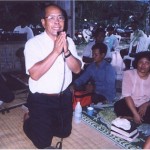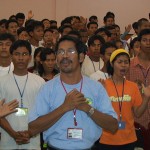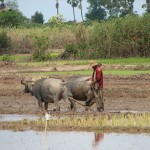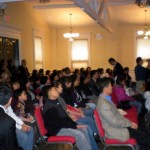January 7, 2010
Living with War – Chapter 4
Cry of the Gecko
Chapter Four Living with War
By 1968, the NVA, by far the strongest military element in Cambodia, had embedded itself in Rattanakiri, Stung Treng and Mondulkiri. These forces in Cambodia were turning Rattanakiri, Mondulkiri and portions of Stung Treng and Kratie Provinces into unchallenged strongholds. Royal Cambodian intelligence estimates had 40,000 NVA and 20,000 Vietcong on Cambodian territory in 1968. These figures were estimated in May of 1968, 10 months before the US secret bombing (Nixon ordered secret bombings of the NVA in Cambodia on March 18 1969). Authors Ben Kieran and John M. Del Vechhio, both with differing perspectives on the evolution of the Khmer Rouge, wrote that the Eastern zone had long been an area where the Khmer Rouge and Khmer Vietminh had been nurtured. The Viet Cong also controlled Highway 3 and funneled arms through the coastal areas Bokor and Kompot, and up Route 4, and from Kompong Speu to the eastern border provinces. Soviet arms flowed down the Ho Chi Minh trails while Chinese arms and munitions came in at the port in Sihanoukville and made their way up Route 4. Khmer communist movements were able to muster between 8000 and 17,000 combat troops. Royal government troops were numbering around 35,000, with 11,000 in combat units. Pol Pot at the time probably could muster 5,000 regular fighters plus about 10,000 irregular guerillas and urban spies.
“US covert teams were operating up to 32 kilometers inside the Cambodian borders, and these incursions increased when President Richard Nixon took office in 1969. In 1969, these incursions increased to close to 200 missions, especially in the first four months of the New Year. Cambodia protested these incursions to the UN. By 1972, the number topped off at close to 2000 incursions.”[1]
“Journalist and author William Shawcross, in his book, Sideshow, wrote that US Special forces had been operating highly classified missions into both Cambodia and Laos since May 1967, and the operations were code named, “Daniel Boone.
Henry Kramm, writing in his book, Cambodia; Reports for a Stricken Land, said that the US ambassador to India, Chester Bowles, got permission from the Prince for the US to launch both air and ground attacks against the Vietcong and NVA in Cambodia. According to Henry Kramm, the prince was dismayed to find in November of 1967, such a strong Vietnamese military presence embedded in eastern Cambodia, and much against his wishes, even though, as other authors on subject report, the prince enjoyed the profit his own forces gained from allowing and helping run supplies to the Vietnamese communists up and down the Ho Chi Minh trail. Steve Heder wrote; “the Prince in January of 1968, gave permission to the US government through a visiting diplomat to pursue attacks on the communist Vietnamese that were fleeing from the fighting into Cambodia.”[2] In spite of Sihanouk’s intense displeasure with the Vietnamese presence, after two anti-Sihanouk rebellions against the prince in Samlot, Battambang on January 22, he told the world he was aligning with North Vietnam.
During Tet, a lunar New Year holiday celebrated in Vietnam on January 30-31, fighting erupted all over South Vietnam. The North Vietnamese and Vietcong launched a major offensive against strategic ARVN and US military bases from Hue to the Mekong Delta which resulted in a series of battles throughout Vietnam below the de-militarized zone. Out posts, fire bases, hospitals, jails, and rear logistical support areas were hit hard.
In Ban Me Thuot, Vietnam, C&MA missionaries working with the tribal people heard what they thought were the celebrations of the Tet holiday, but what they thought were the normal celebratory firecrackers, were actually automatic weapons fire, artillery and mortar rounds crashing in on the surrounding areas. Little did the C&MA missionaries there know this evening there was military action in almost every major city in southern Vietnam and attacks on the US fire base at Khe Sanh. The NVA suffered a heavy military defeat and the Vietcong were all but finished for the rest of the war.
The Tet holiday had normally been the occasion for a truce during war in Vietnam, and the Vietcong had had followed this tradition since their fight against the French. The Vietcong and the NVA let it be known that they would respect a seven day cease-fire from January 31. This would encourage US troops to relax after some tough engagements. ARVN soldiers would go home during the truce. They also deceptively offered to open peace talks during the time of the truce.
To the south the fighting began on January 29th, as Vietcong units began their attacks in four provincial towns. The rest of the enemy attacks began on the night of 30/31st. All but eight provincial capitals were attacked, five of the six cities, and 58 other major towns. Major attacks were targeted for Ban Me Thuot, Quang Nam, Dalat, My Tho, Can Tho, Ben Tre, Nha Trang, and Kontum. Hué, the ancient capital, and Saigon could be counted only as partial successes.
The Vietcong forces lost around 35,000 men killed, 60,000 wounded and 6,000 POWs with little to show for it military, The US and ARVN[3] dead was counted to be around 3,900, over 1000 of that number American servicemen. The popular uprising the NVA hoped for did not happen. It was clearly a military victory for the United States but Hanoi scored a propaganda victory through the western press which would be the turning point of the war as far as US public opinion toward the war effort was concerned. Hanoi’s victory ultimately led to the fall of South Vietnam in March of 1975.
Thirty three year old US AID worker Mike Benge,
an agricultural specialist and former marine from the state of Oregon,
had been working in Ban Me Thout at the time of the Tet. He had been in Vietnam for five years when the Tet offensive began. He spoke fluent Vietnamese as well as various tribal dialects. On January 31st just as the Tet offensive was in full swing, Mike went to check on some Peace Corps workers who were living with Montagnards, and then back to Ban Me Thout to check on some C&MA missionaries who working with the Rhade tribal people in their village on the southern outskirts of Ban Me Thout. On the first day of the Tet, Vietcong attacked the C&MA’s compound, and three staff homes were destroyed, one was home to Rev. Leon Griswald, (who was killed shortly after) and his grown daughter Carolyn, who succombed to wounds from the explosion. During the same attack, Rev. and Mrs. Bob Zeimer, Rev. and Mrs. Ed Thompson and Miss Ruth Whilting came under automatic weapons fire. Only Mrs. Zeimer survived. Rachael Thompson, a missionary with C&MA now in Cambodia and granddaughter of Rev. Thompson, continues to carry on the family tradition. Long time missionary in Cambodia, Beth Drummond is the daughter of the Zeimers. Beth and her husband Rick formerly ministered to the Vietnamese in Cambodia.
Two days later, on February 1, 1968, as Olsen was preparing to escape with the injured Griswald, she and Henry Blood were captured during another attack on the hospital. Over the next few weeks, Benge, Blood and Olsen were held in a POW camp in Dalac Province. While the three were being held in Dalac, on March 16, the My Lai Massacre was carried out by United States troops under the command of Lt. William L. Calley Jr., and two weeks later on March 31, President Johnson stunned the country by announcing he would not run for another term of office.
The two C&MA missionaries, Betty Olsen and Hank Blood, and USAID worker Mike Benge were forced to march through jungle valleys and over countless rugged mountains, without proper food or medicine. Exhausted, lice ridden, dehydrated from diarrhea, suffering from malaria, dengue, scurvy and even beriberi, they were pushed on. Hank Blood contracted pneumonia, weakened steadily, and eventually died in July. Mike and Betty were driven by their cruel captors to somewhere near Tay Ninh Province, then up to Da Lat, then back to Quang Duc Province. Betty Olsen weakened and finally died around September 29, 1968, and was buried by Mike Benge. Mike had recently become a Christian due to the testimony and witness of Hank Blood and Betty Olsen. Their remains had never been recovered. Mike was then turned over to the NVA and moved into Cambodia as he began his long arduous journey to Hanoi. Mike writes, “No medical assistance was ever offered. As a result of malnutrition, I began suffering from beriberi, scurvy, jungle ulcers, loss of hair, and loose teeth. From 160 my weight decreased to less than 100 lbs. As I marched through Cambodia and Laos I passed an endless stream of North Vietnamese uniformed soldiers walking south, and supplies being trucked up from Port of Sihanoukville, Cambodia and down from Hanoi. In Cambodia and Laos, there were rest camps every four hours along the trail flying the North Vietnamese Flag.”
According to Mike’s personal biography[4], after a year in Cambodia, he was marched north on the Ho Chi Minh Trail to Hanoi.
He spent over three years in camps there, including a total of twenty-seven months
in solitary confinement, and was released during "Operation Homecoming" in 1973.[5]
For additional information about the martyred C&MA missionaries, see, No Time for Tombstones, by James and Marti Hefley.
As the new school year began in 1968, recovering Chuck Keller enrolled at Multnomah Bible College in Portland, Oregon (then known as Multnomah School of the Bible), and maintained a close relationship with Central Bible Church where he and his mother had attended since Chuck was five years old. Dr. John G. Mitchell, one of the founders of Multnomah, had served as pastor at the church for many years. While retiring from the pastorate at that time at age 75, he continued to teach at the school and was one of Chuck’s teachers that year. It was hard for him to get back into his studies but he really applied himself to learning New Testament Greek. During that school year of 1968-69 he learned that SIL was offering training in transformational grammar at its course in Grand Forks, North Dakota. He was still accepted with Wycliffe but classified as being on leave. At the summer SIL course, Chuck met his future wife, Sally, who grew up just outside of Grand Rapids, Minnesota and attended Grace Bible Chapel, an independent bible church. Chuck’s own church was also an independent bible church so they had some things in common. By the time they met, Sally had already done three winters at Oak Hills Bible Institute, and one year of practical nursing training. Chuck then attended Bryan College in Tennessee for two years, getting a degree in elementary education. Sally had helped cover her college expenses by working as an LPN.
On May 1st, Prince Sihanouk appointed pro-western Lon Nol as his Defense minister, and as the Khmer Rouge stepped up attacks, Lon Nol was promoted to deputy Prime Minister. In December, Lon Nol was promoted again, this time to acting Prime Minister. By then, Cambodia had lost control of 60% of its land to Vietnamese occupation.
The population of Phnom Penh grew from 400,000 in 1962 to 550,000 in 1968. This large shift to urban centers was happening at about the same time as secularization of a certain segment of society that was drifting from its Buddhist roots and belief in the divinity of the monarchy.
The tragic assassinations of both Dr. Martin Luther King and Robert F. Kennedy add to the intense angst and turmoil experienced by US soldiers in Vietnam and the American people back home.
Personal Testimony of Miss Solina Chy
Daily we hear news of war and terror in many areas of the world. What is your reaction? Are you sensitive to the suffering of those involved? Do you say: “that is just too bad, glad it couldn’t happen to me!” I too, used to have a similar response as I enjoyed the security and luxury of our middle class home in the second largest city in Cambodia. We do not know what tomorrow may bring. Let’s consider what happens to individuals caught up in such an upheaval.
I was such a one. It all happened on April 1975 during the hot season. The communist army known as the Khmer Rouge took over Cambodia. The takeover resulted in the demise of the five year old Republic of Kampuchea.
At first, we had hoped they would bring peace but instead chaos erupted. The Khmer Rouge ordered us to leave the cities immediately and go to the countryside for a period of three days. Before I left home I went up to my room on the third floor, and decided to bring my favorite things, such as picture albums full of photos of my friends, to the first floor where I thought they would be safe. I heard rumors that the United States would drop bombs on the city. Men, women, children and even hospital patients were ordered to leave at gunpoint. My mother, who had been in the hospital for knee surgery, accompanied us. The three days passed but we were not allowed to return home. Instead, the tragic news of killings continued to terrify us. A month later my mother died by the roadside as the result of an infection in her right knee. After a simple cremation we were forced to go on. Step by step, they took all our belongings: car, clothes, blankets, jewelry, medicine, etc. Later I was separated from my father and sisters and was sent to the fields for hard labor. I worked days and nights digging and planting with little food to eat. We were under constant surveillance. Many people were killed. All who were known government officials, soldiers, merchants, and educated people were killed without trial.
One morning when I was walking by the foot of the mountain to water the rice seedlings, I started questioning myself, “Where did I come from?” The answer came to my mind, “From my mother, and my mother from grandma…” I looked to the fields and questioned, “Where did the crops come from, the plants?” But there must have been someone who created the first crop. I started to believe there was one God who created the world whose name I did not know. He is the first one, so no one needed to give Him a name.
Since then, I started to pray every night without letting my friends know that I was interested in another religion even though I had grown up in a Buddhist country. When I prayed, I prayed to my mom, Buddha, Jesus, and the spirits. Jesus I considered to be a god for the white people; one god among many. Lastly, I prayed to the creator God, the only god in the whole world whose name I did not know!
In the middle of 1977, I was put in jail with my feet in the stocks, as the Khmer Rouge tried to force me to marry someone against my will. I refused. They threatened me with electric shock, and by placing a plastic bag over my face while they poured water over my head. I blacked out because of near suffocation. Bayonets were held to my temple. Lastly, they beat me all over my body, accusing me of being an agent for the C.I.A. I lay down on the floor; I could not move as my body was bruised and swollen. My tears started to fall–my heart stirred with hurt, hatred, bitterness, self-pity, anger, and revenge. I thought of my family, for no one knew what had happened to me. I realized more and more there must be one God who is living and watching over me, seeing my tears. As they placed me in the Buddhist temple known as the killing place, I questioned whether or not Buddha could help me for he could not help himself (the idols had been destroyed). During this period, I despaired even of life. Few survived this jail. Two years and three jails later, I emerged alive even though I had been reported dead.
The end of 1978 brought the Vietnamese liberation of Cambodia. The Vietnamese troops invaded Cambodia, causing the Khmer Rouge to flee to the hills. The relaxing of the strict rule of the Khmer Rouge gave opportunity for folks to move more freely within the country. I escaped from the control of the Khmer Rouge and after a few months was reunited with some of my family.
As a family we decided to flee the extreme poverty and unrest of our homeland and escape to Thailand. The past four years had been extremely difficult. For three years I had lived in the open countryside with the ground as my bed, the sky as my roof, hay as my blanket and only one set of clothes. We had long since been stripped of all our belongings. The physical suffering was nothing compared with the mental and emotional anguish.
A deep hatred toward my own people and country had built up in my mind. I said to myself that when my feet reached Thailand I would never return to my country. I also resolved that when I reached a third country I would not associate with the Khmer people. We escaped safely to Thailand, but our suffering did not end there. We were placed in refugee camps with limited food, water, and privacy. The living conditions were appalling, and besides this, there were the daily rumors that we would be sent back to Cambodia. We went through seven different camps. When they sent us to the transit center camp, my dream of freedom seemed imminent but I was again disappointed and confused when my father ended up with a serious medical problem. Staying in Rangsit transit center, I was overwhelmed with self-pity, crying day and night as people we knew passed us on their way to a third country and said, “Oh, you are still here? We thought you were gone already!”
One afternoon in October of 1980, I went to my friend’s place and cried until I fell asleep. My friend woke me up asking me to translate for her because a white lady from ‘Youth with a Mission’ (Y.W.A.M.) came to say good-bye to her. We visited for a while and after she heard my story, she said she was sorry that this was her last day in the camp, as she was moving to work in another camp. About one week later a lady named Yvonne from ‘Youth with a Mission’ came into Rangsit looking for me. She shared with me the gospel; “In the beginning God created the world… On the cross before He died, Jesus said; ‘Father, forgive them; for they do not know what they are doing.’” His Words touched me and I was converted. It was meaningful to me: “God’s Son who had come to earth to show people what God is like…” His death on the cross and how He forgave those who crucified Him although He had done no wrong and His resurrection from the dead…all this was so powerful. If Jesus could forgive His enemies by His power, I could forgive the Khmer Rouge. A miracle happened, and God changed my heart. The bitterness and hatred has been replaced with a deep love for my country and my people. Shortly after that God brought Jody, another YWAM’er, to water me with the Word.
I arrived in Ottawa, Canada in March 1981. First they placed us in the Town Hotel. I was hungry for rice but I did not know where to buy it. A block from the hotel there was a fast food restaurant called Fat Albert’s. I did not know how to order the food, so I stood behind someone at the counter and watched what they ordered then I pointed to the same thing. I asked, “What is it called?” They said, ‘number four’. After that, I ordered the ‘number four’ for lunch and dinner.
I had prayed to find the right church and God prepared the way for me. The second Sunday I was brought to the Metropolitan Bible Church, where there was a small group of Cambodian believers. There I met my adopted Mom, Evelyn Armstrong, a former Overseas Missionary Fellowship worker in Thailand.
I do thank the Lord that He allowed me to know Him first in the refugee camp. I could easily have been swallowed up with the desire for material wealth after years of suffering and poverty. But seek first His kingdom and His righteousness, and all these things shall be added to you!
In 1993, the Lord called me to serve Him in Radio ministry with FEBC (Far East Broadcasting Company) in Manila for three years. I thought, “How can I reach the Khmer people without knowing and seeing their faces? And, I have been away for many years, living in the western world and sure enough– things change on both sides.” When I shared the good news through the microphone in Manila, I felt as though I was talking through a thick curtain but the Lord reminded me of Isaiah 55:11; “So shall My Word be which goes forth from My mouth, It shall not return to Me empty without accomplishing what I desire.”
After my first trip to Cambodia, the thick curtain had been removed ad I could get a clear picture back into my mind of my homeland! God burdened me for my people after my conversion to Jesus Christ and had directed me to work with FEBC Cambodia. In June 1996, the Lord opened the door for me to go back to serve Him among my own people. His confirmation for me was found in Mark 5:19 “Go home to your family and tell them how much the Lord has done for you, and how he has had mercy on you.”
Solina [M1] has served with FEBC, Trans World Radio, Campus Crusade for Christ in Cambodia, and New Life Church in Cambodia.
References
Benge, Mike, Personal Biography, http://www.pownetwork.org/bios/b/b600.htm
Capps, Walter, The Unfinished War. Boston, Beacon Press, 1982
Cormack, Don, Killing Fields, Living Fields. London. Monarch books, 1997
Chy, Solina, Personal Interview, FEBC Office, Phnom Penh, 1997
Barron, Porter, Article on John Kerry’s Account, Cambodia Daily, Wednesday Aug 25th 2004
Jeldres, Julio, King Sihanouk’s Biographer, Cambodia Daily, Wednesday Aug 25th 2004
Hefly, James and Marty, No Time for Tombstones, Tyndale House, Wheaton,1974
Osborne, Milton, Sihanouk, Prince of Light, Prince of Darkness. 1994. Silkworm Books
Kramm, Henry, Cambodia; Reports for a Stricken Land, Arcade Publishing. NY
Website: http://vietnamresearch.com/history/vntimeline.html
WE CAME HOME copyright 1977 Captain and Mrs. Frederic A Wyatt (USNR Ret), Barbara Powers Wyatt, P.O.W. Publications, Toluca Lake, CA. 1977
Written by: Cambodianchristian.Com
Filed Under: Chapter 4, Cry of the Gecko - By Brian Maher
Trackback URL: http://www.cambodianchristian.com/article/wp-trackback.php?p=304






